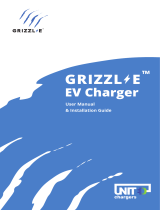
10
2. Installation Planning and Service Wiring:
WARNING: Disconnect the power supply to the charging station
before installing, adjusting, or repairing the charging. Failure to do so
may result in physical injury or damage to the power supply system
and the charging station.
CAUTION: To reduce the risk of fire, connect only to a circuit
provided with the minimum branch circuit overcurrent protection
requirements in accordance with the National Electrical Code ANSI/
NFPA 7- and the Canadian Electrical Safety Code, Part 1, C22.1. If
you are unsure if your circuit meets these requirements consult a
licensed electrician.
2.1 Electrical Source Requirements
• Prior to mounting, locate an available electrical source that can support the following
Input Requirements for the Charging Station Per local Electrical Safety Code requirements:
»40A Maximum Output Setting (Default Factory Setting): a DEDICATED CIRCUIT rated
for 50A; 208VAC Single Phase or 240VAC Split Phase, 50-60 Hz,
»32A Maximum Output Setting (Default Factory Setting): a DEDICATED CIRCUIT rated
for 40A; 208VAC Single Phase or 240VAC Split Phase, 50-60 Hz,
»24A Maximum Output Setting (Default Factory Setting): a DEDICATED CIRCUIT rated
for 30A; 208VAC Single Phase or 240VAC Split Phase, 50-60 Hz,
» 16A Maximum Output Setting (Default Factory Setting): a DEDICATED CIRCUIT rated
for 20A; 208VAC Single Phase or 240VAC Split Phase, 50-60 Hz,
• A Double Pole Circuit Breaker of the circuit rating must be used.
• The Charger is equipped with GFCI. Additional downstream GFCI is not required. In
locations where GFCI at the outlet is mandated by code, the charger will not experience
negative effects.
• The Charging Stations can connect a Standard NEMA 6-50 or 14-50 Receptacle, or the unit
can be hardwired. Do not use this device with an extension cord or electrical adapter.
• It is recommended to use Grizzl-E Chargers with a Circuit Breaker. It is not recommended
to use a Fuse Box as this can lead to unexpected blown fuses.
2.2 Grounding Instructions
The charging station must be implemented equipment grounding through a permanent
wiring system or an equipment grounding conductor. Use a cable with a dedicated grounding
conductor connected to the equipment ground terminal block.



























